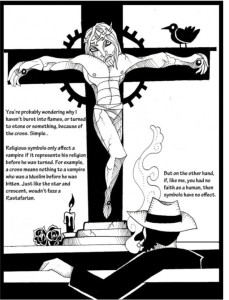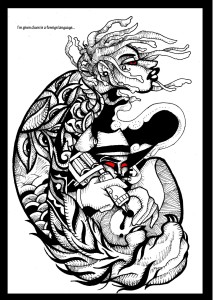DayBlack: A different kind of vampire tale

We as a culture seem to have a deep and abiding fascination with vampires, those ravenous, blood-sucking creatures of the night. From Nosferatu and Vlad Ţepeş to Marvel Comics’ Blade, to the vampires of True Blood and Twilight, vampires have taken many forms and continue to inhabit both the night and our darkest fears. In a more modern-day setting, writer, illustration, tattoo artist Keef Cross also had a vampire story in his head, and, now, in print. His comicbook — DayBlack, (published by Rosarium) is the story of Cross’ vampire, named Merce, who is a 400-year old former slave who now lives in that town of DayBlack, Georgia, which lies beneath the polluted clouds of decades of industrial waste that has literally obscured the sun. In fact the town’s sky is so dense with pollution that the sun is nowhere to be seen, allowing Merce to move about freely, night or day.
 Merce’s story is that, after hundreds of years of killing to survive, he no longer has the desire to simply exist…he wants to actually live. DayBlack then, is the story of how Merce, attempts to do just that. As the tale opens we meet this unlikely vampire as he plies his trade as a tattoo artist in the small town. Given the particular nature of the locale, he has been able to successfully hide that he is well, undead. However, even darker than the black clouds that cover his town, are the dreams that have recently been plaguing Merce. As if the hallucinogenic dreams aren’t bad enough, he is lately suffering from narcolepsy, causing him to fall into a deep slumber at the oddest moments (sometimes while he’s tattooing someone). As Merce attempts to decipher his dreams, his adopted son, whom Merce hasn’t seen in years, returns with plans for him — plans that threaten his new way of life turning him back into the cold-hearted killer he once was.
Merce’s story is that, after hundreds of years of killing to survive, he no longer has the desire to simply exist…he wants to actually live. DayBlack then, is the story of how Merce, attempts to do just that. As the tale opens we meet this unlikely vampire as he plies his trade as a tattoo artist in the small town. Given the particular nature of the locale, he has been able to successfully hide that he is well, undead. However, even darker than the black clouds that cover his town, are the dreams that have recently been plaguing Merce. As if the hallucinogenic dreams aren’t bad enough, he is lately suffering from narcolepsy, causing him to fall into a deep slumber at the oddest moments (sometimes while he’s tattooing someone). As Merce attempts to decipher his dreams, his adopted son, whom Merce hasn’t seen in years, returns with plans for him — plans that threaten his new way of life turning him back into the cold-hearted killer he once was.
Recently, we had the opportunity to speak at length with Cross, who filled us in a bit on how he not only got to where he currently is, but how he developed his unusual take on vampires.
RJS: Tell us a little bit about DayBlack, where did the idea originate?
Keef: The idea for DayBlack came from working in a tattoo shop, and meeting so many colorful characters, and having conversations with people that I normally wouldn’t, simply because I’m doing their tattoo.
 RJS: I understand that you are a tattoo artist, how did that figure into the creation of DayBlack and its characters?
RJS: I understand that you are a tattoo artist, how did that figure into the creation of DayBlack and its characters?
Keef: So in the beginning it was just a tattoo artist character I would draw, talking with customers, sort of like a Sunday comic strip, this was before I added the vampire/slave aspect. Then during the winter months the tattoo business slows down considerably, allowing me the time to work on the story.
RJS: Tell us a bit about your artistic background.
Keef: I’ve been drawing since middle school, and in high school I attended the Tri-Cities Visual and Performing Arts Magnet Program. When I graduated, I got a full scholarship to the Columbus College of Art and Design in Ohio where I majored in illustration, but the crazy thing is, I was taking a comicbook design class. At the time, I didn’t want to do comics, so I didn’t really take the class seriously, so 15 years later, as I’m doing my book, I’m racking my brain trying to remember those jewels my teacher used to drop on us. This may have contributed to my approach on my book, because I really just do it the way I want and don’t try to follow an accepted standard, I’m not sure if that’s a good thing, but that’s how it worked out.
 RJS: Why vampires? What is it about vampires that attract us as a culture?
RJS: Why vampires? What is it about vampires that attract us as a culture?
Keef: I don’t know what it is about vampires! They refuse to go away! We can’t seem to get enough… I’ve never been particularly partial to them.
RJS: How did you come up with the story itself? What prompted you to do this particular story?
Keef: As far as DayBlack goes, I really think the idea came from being in the tattoo industry and dealing with things like blood-borne pathogens, sterilization, needles, pain, and being exposed to the subculture of tattoo life. Leaving work at 2 a.m. and being out all night with real vampires. All of that rolled around in my head, until I came up with Merce [the main character in DayBlack].
 RJS: Do you tend to watch (or read) other vampire tales? If so, which are better than others? Which would you recommend?
RJS: Do you tend to watch (or read) other vampire tales? If so, which are better than others? Which would you recommend?
Keef: I was never into the whole, “blah, I vant to suck your blood” vampires, if I did it, it had to be something socially and culturally relevant, this also where the HIV angle came to play.
RJS: How did you get hooked up with Rosarium publishing?
Keef: I linked with Rosarium publishing from Facebook, would post pics of DayBlack pretty regularly, and Bill Campbell, the publisher of Rosarium, reached out to me, explained that he was a new publishing entity and asked if he could publish DayBlack. He already had John Jennings on the roster, who I admired, so it was a no-brainer, that and self-publishing was kicking my ass.
RJS: What, if anything, can we as humans learn from the experiences or the events of a vampire living among us?
Keef: I really don’t see anything valuable that a human could take from traditional vampires, there isn’t too much common ground there. I really wanted Merce to be relatable especially to someone who has been told their entire life that they could only be one thing, but strives to be something more.
 RJS: Do you think it is OK to “screw with” the mythology of vampires or similar characters?
RJS: Do you think it is OK to “screw with” the mythology of vampires or similar characters?
Keef: I think it’s absolutely OK to screw with the mythology of anything that doesn’t really exist. Nothing should be off limits, as long as core traits and characteristics are respected to some extent, then it’s all good. That keeps it fresh. That’s why I don’t really mind stuff like Twilight because even though it’s kinda pussyfied, it’s original. Since I began DayBlack, I try not to watch a whole lot of vampire stuff with the exception of True Blood, which I love, and I’m a huge fan of Bram Stoker’s Dracula, and the Blade movies, but if I had to liken DayBlack to any film, aesthetically and tone wise it would be a Jim Jarmusch film mixed with Spike Lee.
RJS: Will this be an on-gong series of comics or do you have a definitive end to it?
Keef: I do have a definite ending to this particular story arc, but it definitely has the potential to be an ongoing series focusing on not only Merce but other supernatural characters who inhabit DayBlack.
Cross indicated to us that issue #4 of DayBlack is due out soon, and will be available from both Rosarium and Amazon.
DayBlack, and all artwork associated with the graphic novel is copyright © 2015 Keef Cross. DayBlack is published by Rosarium. All rights reserved.
The text to Funnybook City is © 2015 Robert J. Sodaro, D.B.A. Freelance Ink. All rights reserved.
Robert J. Sodaro is a noted comicbook historian and journalist who began reading comics during the early ‘60 while sitting on the newsstand in his Uncle’s “Mom & Pop” grocery store. He has been writing about them in the early ‘80s, and wrote for virtually every print comicbook publication published during the ‘80s & ‘90s. These days, much of his writing can be found on Examiner.com.

Leave a Reply